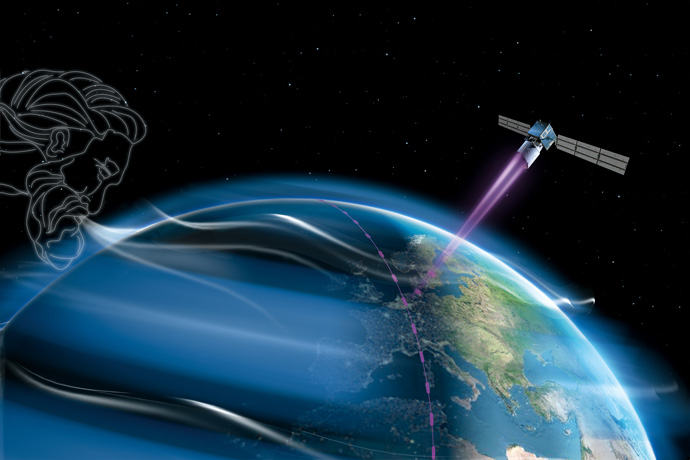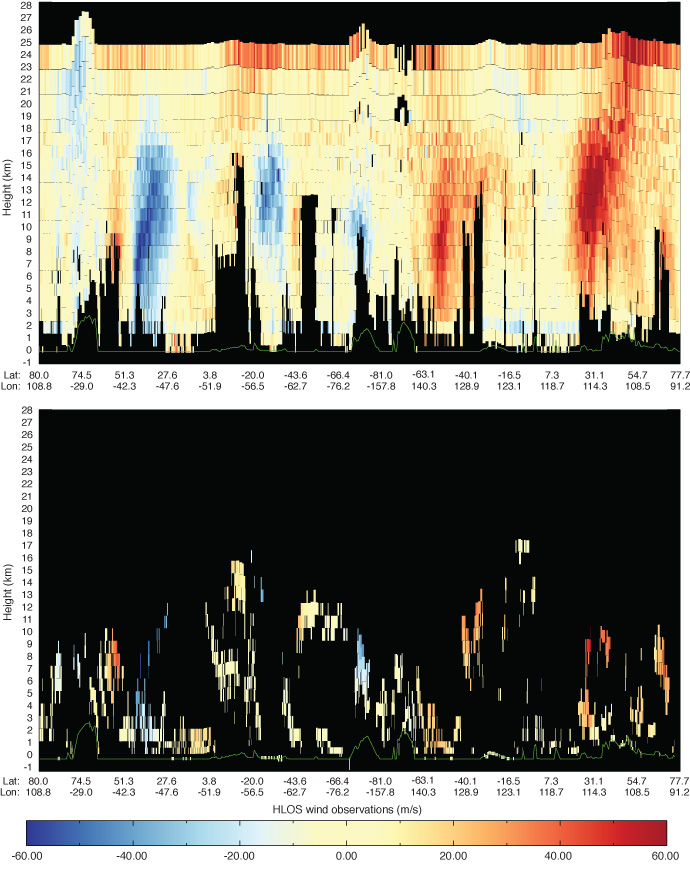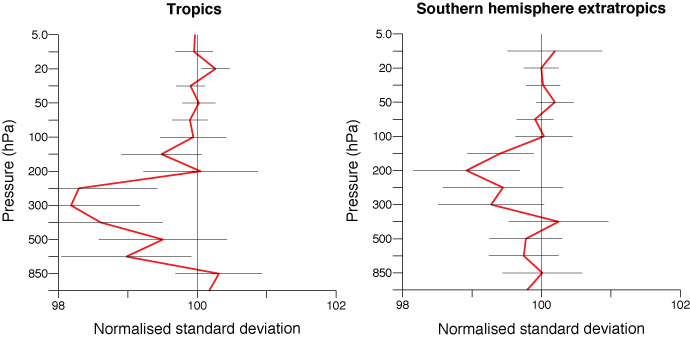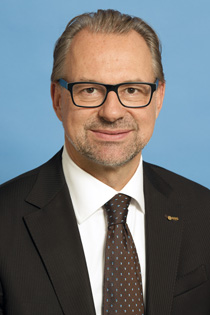

Aeolus can measure winds up to an altitude of about 30 km. (Image: ESA/AOES Medialab)
A first evaluation of data from the Aeolus satellite launched by ESA in August 2018 has confirmed that the mission’s ground-breaking laser technology can be used to obtain global wind profiles that are very useful to numerical weather prediction (NWP).
“Assessments at ECMWF, the German national meteorological service (DWD) and the UK Met Office have demonstrated that Aeolus wind data have a positive impact,” says Lars Isaksen, the Head of Actively Sensed Observations at ECMWF.
ECMWF has been working closely with ESA, the German Aerospace Centre (DLR), Météo-France, the Dutch national meteorological service (KNMI) and the software company DoRIT since the first Aeolus wind data became available in September 2018 to identify and resolve any data quality issues and to contribute to improved data processing.

The plots show Aeolus horizontal-line-of-sight (HLOS) wind measurements for a typical orbit on 27 February 2019. The top panel shows ‘Rayleigh Clear’ measurements. These are obtained from the backscatter of laser light from clear air molecules. The ‘Mie Cloudy’ measurements shown in the bottom panel are complementary returns from clouds and aerosols. Measurements are not available below thick clouds that block the laser light. Mie measurements are more accurate but are only available for some parts of the atmosphere.
The goal is to eventually use Aeolus data to help determine the initial conditions from which weather forecasts start. The best way to assess the impact of the data is to run forecasts from analyses produced with and without them and to compare the results against trusted observations and analyses.
“Such experiments show a statistically significant impact on short-range forecasts at a range of altitudes, especially in the tropics and the southern hemisphere,” says Michael Rennie, who has carried out much of the evaluation work at ECMWF.
“These are very encouraging results given that there were still many issues with the quality of the observations when these preliminary experiments were run, such as biases that vary along the orbit.”

The plots show relative changes in the errors of 12-hour forecasts of wind speeds, compared to radiosonde and wind profiler data, when Aeolus data are used to help determine the initial conditions. Values below 100% mean an improved fit to observations. The horizontal bars indicate 95% confidence intervals. The experiments cover the commissioning phase from 12 September 2018 to 12 January 2019.
An important part of ECMWF’s work on the data is to detect and remove biases. “A lot of progress has been made in this regard,” says Lars. “When an improved Aeolus data processor is implemented by ESA in the coming weeks, it is anticipated that the impact on forecasts will increase significantly.”
Close ties with ESA
Lars and Michael presented ECMWF’s results at ESA’s Living Planet Symposium in May in Milan. The Centre’s significant presence at the event – a 17-strong delegation headed by Director-General Florence Rabier – testifies to the close collaboration between ESA and ECMWF, not just on Aeolus but also on other satellite missions.
Some of these are related to numerical weather prediction, such as ESA’s Soil Moisture and Ocean Salinity (SMOS) mission and the joint European/Japanese EarthCARE satellite to be launched in 2022.
ECMWF scientist Patricia de Rosnay gave a presentation on SMOS soil moisture data assimilation for operational NWP, and Marta Janiskova and Mark Fielding gave a talk on the potential for improving weather forecasts by assimilating space-borne cloud radar and lidar observations, due to be delivered by EarthCARE. In addition, Giovanna De Chiara presented recent progress at ECMWF on the use of near-surface ocean scatterometer winds in NWP.
Other ESA missions, such as the Sentinel missions, are of crucial importance to the two EU-funded environmental services implemented by ECMWF: the Copernicus Atmosphere Monitoring Service (CAMS) and the Copernicus Climate Change Service (C3S). The transformation of C3S from proof-of-concept to a fully operational service was presented by the Head of C3S, Jean-Noël Thépaut.
“The cooperation between ESA and ECMWF is going extremely well,” says Josef Aschbacher, the Director of Earth Observation Programmes at ESA. “ECMWF is complementary to what we do because the Centre uses ESA data for numerical weather prediction and also gives us extremely useful input from a science and modelling perspective to validate the data from our satellites and to help us define future satellite instrument requirements.”
 On Aeolus, he emphasises that the mission uses new technology and is therefore also about learning lessons. “This is the first time a UV lidar is flying successfully in space. The purpose of this mission was to demonstrate whether or not this technology can work, and we now know it works. There are still some technological problems, such as slight lidar degradation, but this does not diminish the results obtained so far.”
On Aeolus, he emphasises that the mission uses new technology and is therefore also about learning lessons. “This is the first time a UV lidar is flying successfully in space. The purpose of this mission was to demonstrate whether or not this technology can work, and we now know it works. There are still some technological problems, such as slight lidar degradation, but this does not diminish the results obtained so far.”
He adds: “ECMWF has been excellent in assimilating the data and comparing them with other observations and model results. The Aeolus data are very positive in terms of future improvements in numerical weather prediction. As a result, EUMETSAT has asked us to consider studies for an operational Aeolus follow-on mission, incorporating the lessons learnt. If those preparations are positive, I would like to make a proposal for such a mission at our Ministerial Council in 2022.”
Photo of Josef Aschbacher: ESA-Philippe Sebirot
